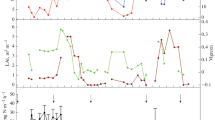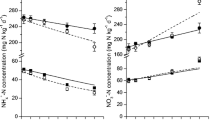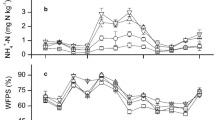Abstract
Tea fields represent an important source of nitrous oxide (N2O) and nitric oxide (NO) emissions due to high nitrogen (N) fertilizer applications and very low soil pH. To investigate the temporal characteristics of N2O and NO emissions, daily emissions were measured over 2½ years period using static closed-chamber/gas chromatograph and chemiluminescent measurement system in a tea field of subtropical central China. Our results revealed that N2O and NO fluxes showed similar temporal trends, which were generally driven by temporal variations in soil temperature and soil moisture content and were also affected by fertilization events. The measured average annual N2O and NO emissions were 10.9 and 3.3 kg N ha−1 year−1, respectively, highlighting the high N2O and NO emissions from tea fields. To improve our understanding of N-cycling processes in tea ecosystems, we developed a new nitrogenous gas emission module for the water and nitrogen management model (WNMM, V2) that simulated daily N2O and NO fluxes, in which the NO was simulated as being emitted from both nitrification and nitrite chemical decomposition. The results demonstrated that the WNMM captured the general temporal dynamics of N2O (NSE = 0.40; R2 = 0.52, RMSE = 0.03 kg N ha−1 day−1, P < 0.001) and NO (NSE = 0.41; R2 = 0.44, RMSE = 0.01 kg N ha−1 day−1, P < 0.001) emissions. According to the simulation, denitrification was identified as the dominant process contributing 76.5% of the total N2O emissions, while nitrification and nitrite chemical decomposition accounted for 52.3 and 47.7% of the total NO emissions, respectively.




Similar content being viewed by others
References
Akiyama H, Yan X, Yagi K (2006) Estimations of emission factors for fertilizer-induced direct N2O emissions from agricultural soils in Japan: summary of available data. Soil Sci Plant Nutr 52:774–787
Aranibar JN, Otter L, Macko SA, Feral CJW, Epstein HE, Dowty PR, Eckardt F, Shugart HH, Swap RJ (2004) Nitrogen cycling in the soil–plant system along a precipitation gradient in the Kalahari sands. Glob Change Biol 10:359–373
Bell MJ, Jones E, Smith J, Smith P, Yeluripati J, Augustin J, Juszczak R, Olejnik J, Sommer M (2012) Simulation of soil nitrogen, nitrous oxide emissions and mitigation scenarios at 3 European cropland sites using the ECOSSE model. Nutr Cycl Agroecosyst 92:161–181
Bouwman AF, Stehfest E, Vankessel C (2010) Nitrous oxide emissions from the nitrogen cycle in arable agriculture: estimation and mitigation. In: Smith K (ed) Nitrous oxide and climate change. Earthscan, London, pp 1–240
Bremner JM (1997) Sources of nitrous oxide in soils. Nutr Cycl Agroecosyst 49:7–16
Butterbach-Bahl K, Stange F, Papen H, Li C (2001) Regional inventory of nitric oxide and nitrous oxide emissions for forest soils of southeast Germany using the biogeochemical model PnET-N-DNDC. J Geophys Res Atmos 106:34155–34166
Butterbach-Bahl K, Kahl M, Mykhayliv L, Werner C, Kiese R, Li C (2009) A European-wide inventory of soil NO emissions using the biogeochemical models DNDC/Forest-DNDC. Atmos Environ 43:1392–1402
Cai Z, Sawamoto T, Li C, Kang G, Boonjawat J, Mosier A, Wassmann R, Tsuruta H (2003) Field validation of the DNDC model for greenhouse gas emissions in East Asian cropping systems. Glob Biogeochem Cycles 17:1107. doi:10.1029/2003GB002046
Chatskikh D, Olesen JE, Berntsen J, Regina K, Yamulki S (2005) Simulation of effects of soils, climate and management on N2O emission from grasslands. Biogeochemistry 76:395–419
Chen D, Li Y, Grace P, Mosier AR (2008) N2O emissions from agricultural lands: a synthesis of simulation approaches. Plant Soil 309:169–189
Chen QL, Zhan YQ, Wu HS, Wang RZ, Wan L (2012) Nitrogen leaching in various soil–crop systems. In: Proceedings of the 12th Congress of Soil Science Society of China. Future Soil Science III, Jiangsu Science and Technology Press, Nanjing, China, p 1265 (in Chinese)
Conrad WJ (1990) Flux of NO x between soil and atmosphere: importance and soil microbial metabolism. In: Sorenson J, Revebech NP (eds) Denitrification in soil and sediment, vol 56. Plenum Press, New York, pp 105–128
Cui M, Caldwell MM (1997) A large ephemeral release of nitrogen upon wetting of dry soil and corresponding root response in the field. Plant Soil 191:291–299
Davidson EA (1992) Sources of nitric oxide and nitrous oxide following wetting of dry soil. Soil Sci Soc Am J 56:95–102
Davidson EA (2009) The contribution of manure and fertilizer nitrogen to atmospheric nitrous oxide since 1860. Nat Geosci 2:659–662
Davidson EA, Stark JM, Firestone MK (1990) Microbial production and consumption of nitrate in an annual grassland. Ecology 71:1968–1975
Davidson EA, Keller M, Erickson HE, Verchot LV, Veldkamp E (2000) Testing a conceptual model of soil emissions of nitrous and nitric oxides. Bioscience 50:51–60
Eickenscheidt N, Brumme R (2012) NO x and N2O fluxes in a nitrogen-enriched European spruce forest soil under experimental long-term reduction of nitrogen depositions. Atmos Environ 60:51–58
Engel T, Priesack E (1993) Expert-N—a building block system of nitrogen models as resource for advice, research, water management and policy. In: Eijsackers H, Hamers T (eds) Integrated soil and sediment research: a basic for proper protection. Kluwer, Dordrecht, pp 503–507
Fang S, Yujing M (2009) NO x fluxes from several typical agricultural fields during summer-autumn in the Yangtze Delta, China. Atmos Environ 43:2665–2671
Firestone MK, Davidson EA (1989) Microbiological basis of NO and N2O production in soil. In: Andreae MO, Schimel DS (eds) Exchange of trace gases between terrestrial ecosystems and the atmosphere. Wiley, Hoboken, pp 7–21
Franz XM, Wen XY (2005) Biogenic emissions of nitric oxide and nitrous oxide from arid and semi-arid land. In: D’Odorico P, Porporato A (eds) Dryland ecohydrology. Springer, Dordrecht, pp 233–255
Fu XQ, Li Y, Su WJ, Shen JL, Xiao RL, Tong CL, Wu J (2012) Annual dynamics of N2O emissions from a tea field in southern subtropical China. Plant Soil Environ 58:373–378
Fukumoto Y (2012) Nitration promotion process for reducing nitrogen losses by N2O/NO emissions in the composting of livestock manure. In: Hernandez-Soriano MC (ed) Soil health and land use management. Intech, Maastricht, pp 155–174
Gabrielle B (2006) Sensitivity and uncertainty analysis of a static denitrification model. In: Wallach D, Makowski D, Jones JW (eds) Working with dynamic crop models: evaluating, analyzing, parameterizing and using them. Elsevier, Amsterdam, pp 359–366
Goodroad LL, Keeney DR (1984) Nitrous oxide production in aerobic soils under varying pH, temperature and water content. Soil Biol Biochem 16:39–43
Grant RF (2001) A review of the Canadian ecosystem model ecosys. In: Shaffer M (ed) Modeling carbon and nitrogen dynamics for soil management. CRC Press, Boca Raton, pp 175–264
Groffman PM, Brumme R, Butterbach-Bahl K, Dobbie KE, Mosier AR, Ojima D, Papen H, Parton WJ, Smith KA, Wagner-Riddle C (2000) Evaluating annual nitrous oxide fluxes at the ecosystem scale. Glob Biogeochem Cycles 14:1061–1070
Guo JH, Liu XJ, Zhang Y, Shen JL, Han WX, Zhang WF, Christie P, Goulding KWT, Vitousek PM, Zhang FS (2010) Significant acidification in major Chinese croplands. Science 327:1008–1010
Han W, Kemmitt SJ, Brookes PC (2007) Soil microbial biomass and activity in Chinese tea gardens of varying stand age and productivity. Soil Biol Biochem 39:1468–1478
He JZ, Shen JP, Zhang LM, Zhu YG, Zheng YM, Xu MG, Di H (2007) Quantitative analyses of the abundance and composition of ammonia-oxidizing bacteria and ammonia-oxidizing archaea of a Chinese upland red soil under long-term fertilization practices. Environ Microbiol 9:2364–2374
Henault C, Bizouard F, Laville P, Gabrielle B, Nicoullaud B, Germon JC, Cellier P (2005) Predicting in situ soil N2O emission using NOE algorithm and soil database. Glob Change Biol 11:115–127
Hirono Y, Nonaka K (2012) Nitrous oxide emissions from green tea fields in Japan: contribution of emissions from soil between rows and soil under the canopy of tea plants. Soil Sci Plant Nutr 58:384–3922
Hou AX, Tsuruta H (2003) Nitrous oxide and nitric oxide fluxes from an upland field in Japan: effect of urea type, placement, and crop residues. Nutr Cycl Agroecosyst 65:191–200
Huang Y, Li Y, Yao H (2014) Nitrate enhances N2O emission more than ammonium in a highly acidic soil. J Soils Sediments 14:146–154
Hutchinson GL, Vigil MF, Doran JW, Kessavalou A (1997) Coarse-scale-atmosphere NO x exchange modeling: status and limitations. Nutr Cycl Agroecosyst 48:25–35
Intergovernmental Panel of Climate Change (2013) Climate Change 2013: the physical science basis: contribution of Working Group I to the Fifth Assessment Report of the Intergovernmental Panel on Climate Change. Cambridge University Press, New York
Johnsson H, Bergstrom L, Jansson P, Paustian K (1987) Simulated nitrogen dynamics and losses in a layered agricultural soil. Agric Ecosyst Environ 18:333–356
Kesik M, Ambus P, Baritz R, Brüggemann N, Butterbach-Bahl K, Damm M, Duyzer J, Horváth L, Kiese R, Kitzler B, Leip A, Li C, Pihlatie M, Pilegaard K, Seufert S, Simpson D, Skiba U, Smiatek G, Vesala T, Zechmeister-Boltenstern S (2005) Inventories of N2O and NO emissions from European forest soils. Biogeosciences 2:353–375
Laville P, Hénault C, Gabrielle B, Serça D (2005) Measurement and modeling of NO fluxes on maize and wheat crops during their growing seasons: effect of crop management. Nutr Cycl Agroecosyst 72:159–171
Laville P, Lehuger S, Loubet B, Chaumartin F, Cellier P (2011) Effect of management, climate and soil conditions on N2O and NO emissions from an arable crop rotation using high temporal resolution measurements. Agric For Meteorol 151:228–240
Li CS (2000) Modeling trace gas emissions from agricultural ecosystems. Nutr Cycl Agroecosyst 58:257–276
Li D, Wang X (2007) Nitric oxide emission from a typical vegetable field in the Pearl River Delta, China. Atmos Environ 41:9498–9505
Li C, Aber J, Stange F, Butterbach-Bahl K, Papen H (2000) A process-oriented model of N2O and NO emissions from forest soils. J Geophys Res 105:4369–4384
Li Y, Chen D, Zhang Y, Edis R, Ding H (2005) Comparison of three modeling approaches for simulating denitrification and nitrous oxide emissions from loam-textured arable soils. Glob Biogeochem Cycles. doi:10.1029/2004GB002392
Li Y, White R, Chen D, Zhang J, Li B, Zhang Y, Huang Y, Edis R (2007) A spatially referenced water and nitrogen management model (WNMM) for (irrigated) intensive cropping systems in the North China Plain. Ecol Modell 203:395–423
Li Y, Fu X, Liu X, Shen J, Luo Q, Xiao R, Li Y, Tong C, Wu J (2013) Spatial variability and distribution of N2O emissions from a tea field during the dry season in subtropical central China. Geoderma 193–194:1–12
Lin Y, Han W (2009) N2O emissions from different soils. Chin J Tea Sci 29:456–464
Linn DM, Doran JW (1984) Effect of water-filled pore space on carbon dioxide and nitrous oxide production in tilled and nontilled soils. Soil Sci Soc Am J 48:1667–1672
Liu S, Reiners WA, Keller M, Schimel DS (2000) Simulation of nitrous oxide and nitric oxide emissions from tropical primary forests in the Costa Rican Atlantic Zone. Environ Model Softw 15:727–743
Liu C, Zheng X, Zhou Z, Han S, Wang Y, Wang K, Liang W, Li M, Chen D, Yang Z (2010) Nitrous oxide and nitric oxide emissions from an irrigated cotton field in Northern China. Plant Soil 332:123–134
Monteny G, Bannink A, Chadwick D (2006) Greenhouse gas abatement strategies for animal husbandry. Agric Ecosyst Environ 112:163–170
NBSC (2014) China Statistical Yearbook, annual publication, National Bureau of Statistics of China, Beijing. http://www.stats.gov.cn/tjsj/ndsj/2014/indexeh.htm. Last access 1 Oct 2014
Norman J, Jansson P, Farahbakhshazad N, Butterbach-Bahl K, Li C, Klemedtsson L (2008) Simulation of NO and N2O emissions from a spruce forest during a freeze/thaw event using an N-flux submodel from the PnET-N-DNDC model integrated to Coupmodel. Ecol Modell 216:18–30
Pang XB, Mu YJ, Lee XQ, Fang SX, Yuan J, Huang DK (2009) Nitric oxides and nitrous oxide from typical vegetables cropland in China: effect of cannoy, soil properties and field management. Atmos Environ 43:2571–2578
Parton WJ, Holland EA, Del Grosso SJ, Hartman MD, Martin RE, Mosier AR, Ojima DS, Schimel DS (2001) Generalized model for NO x and N2O emissions from soil. J Geophys Res Atmos 106:17403–17419
Pilegaard K (2013) Processes regulating nitric oxide emissions from soils. Philos Trans R Soc B. doi:10.1098/rstb.2013.126
Potter CS, Matson PA, Vitousek PM, Davidson EA (1996) Process modeling of controls on nitrogen trace gas emissions from soils worldwide. J Geophys Res Atmos 101:1361–1377
Prisley SP, Mortimer MJ (2004) A synthesis of literature on valuation of models for policy applications, with implications or forest carbon accounting. For Ecol Manag 98:89–103
Remde A, Conrad R (1991) Role of nitrification and denitrification for NO metabolism in soil. Biogeochemistry 12:189–205
Riley WJ, Matson PA (2000) Nloss: a mechanistic model of denitrified N2O and N2 evolution from soil. Soil Sci 165:237–249
Rolland MN, Gabrielle B, Laville P, Serça D, Cortinovis J, Larmanou E, Lehuger S, Cellier P (2008) Modeling of nitric oxide emissions from temperate agricultural soils. Nutr Cycl Agroecosyst 80:75–93
Shen JL, Li Y, Liu XL, Luo XS, Zhang YZ, Wu J (2013) Atmospheric dry and wet nitrogen deposition on three contrasting land use types of agricultural catchment in subtropical central China. Atmos Environ 67:415–424
Skiba U, Fowler D, Smith KA (1997) Nitric oxide emissions from agricultural soils in temperate and tropical climate: sources, controls and mitigation options. Nutr Cycl Agroecosyst 48:139–153
Tokuda S, Hayatsu M (2000) Nitrous oxide production from strongly acid tea field soil. Soil Sci Plant Nutr 46:835–844
Trebs I (2001) Primäregenwäder and brandgerodete Gebiete in Brasilien, Untersuchungen zur Freisetzung und Aufnahme von Stickstoffmonoxid (NO) an Bodenproben im Labormaßsstab, Hochschule für Technik, Wirtschaft und Kultur, Leipzig, Germany, p 58
Venterea RT, Rolston DE (2000) Mechanisms and kinetics of nitric and nitrous oxide production during nitrification in agricultural soil. Glob Change Biol 6:303–316
Wang JY, Cardenas LM, Misselbrook TH, Cuttle S, Thorman RE, Li CS (2012) Modelling nitrous oxide emissions from grassland systems. Environ Pollut 162:223–233
Williams EJ, Guenther A, Fehsenfeldi FC (1992) An inventory of nitric oxide emissions from soils in the United States. J Geophys Res 97:1033–1042
Wu X, Ru GM (1986) Uptake and utilizing nitrogen fertilizer by tea plant. J Tea Sci 6:15–24 (in Chinese)
Wu X, Zhang A (2014) Comparison of three models for simulating N2O emissions from paddy fields under water-saving irrigation. Atmos Environ 98:500–509
Yan X, Ohara T, Akimoto H (2005) Statistical modeling of global soil NO x emissions. Glob Biogeochem Cycles 19:1–16
Yao Z, Wei Y, Liu C, Zheng X, Xie B (2015) Organically fertilized tea plantation simulates N2O emissions and lowers NO fluxes in subtropical China. Biogeosciences 12:5915–5928
Yienger JJ, Levy H (1995) Empirical model of global soil-biogenic NO x emissions. J Geophys Res 11:447–464
Zhang Y, Liu J, Mu Y, Pei S, Lun X, Chai F (2011) Emissions of nitrous oxide, nitrogen oxides and ammonia from a maize field in the North China Plain. Atmos Environ 45:2956–2961
Zheng X, Mei B, Wang Y, Xie B, Wang Y, Dong H, Xu H, Chen G, Cai Z, Yue J, Gu J, Su F, Zou J, Zhu J (2008) Quantification of N2O fluxes from soil–plant systems may be biased by the applied gas chromatograph methodology. Plant Soil 311:211–234
Zhu T, Zhang J, Meng T, Zhang Y, Yang J, Müller C, Cai Z (2014) Tea plantation destroys soil retention of NO3 − and increases N2O emissions in subtropical China. Soil Biol Biochem 73:106–114
Zou J, Huang Y, Lu Y, Zheng X, Wang Y (2005) Direct emission factor for N2O from rice–winter wheat rotation systems in southeast China. Atmos Environ 39:4755–4765
Acknowledgements
This research was financially supported by the National Natural Science Foundation of China (41671243) and the National Basic Research Program of China (2012CB417105).
Author information
Authors and Affiliations
Corresponding author
Electronic supplementary material
Below is the link to the electronic supplementary material.
Rights and permissions
About this article
Cite this article
Chen, D., Li, Y., Wang, C. et al. Measurement and modeling of nitrous and nitric oxide emissions from a tea field in subtropical central China. Nutr Cycl Agroecosyst 107, 157–173 (2017). https://doi.org/10.1007/s10705-017-9826-1
Received:
Accepted:
Published:
Issue Date:
DOI: https://doi.org/10.1007/s10705-017-9826-1




